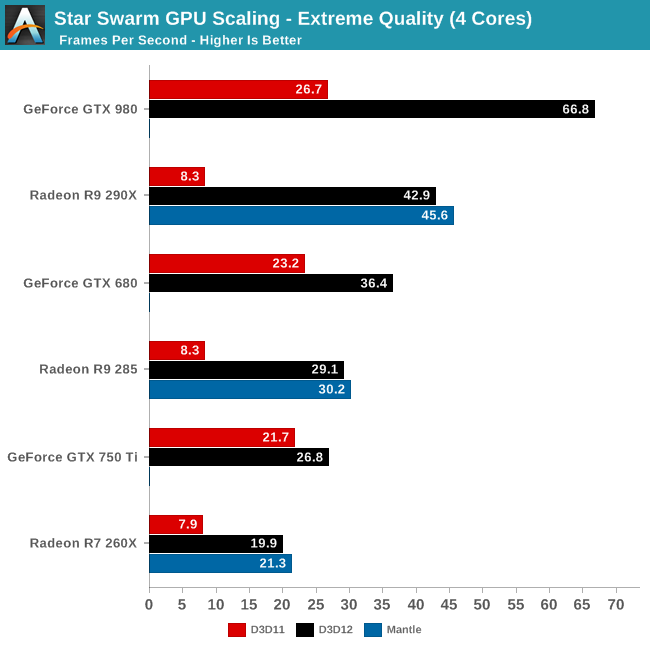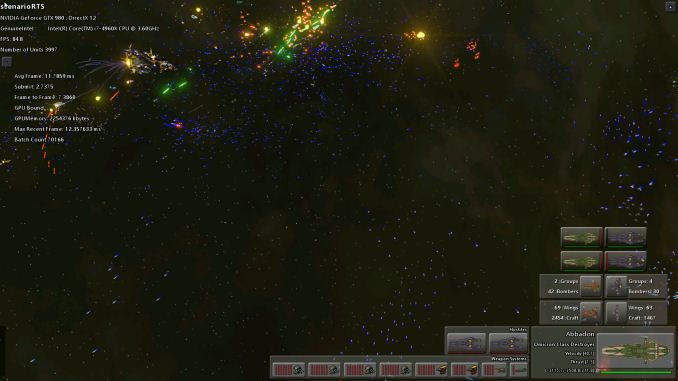The DirectX 12 Performance Preview: AMD, NVIDIA, & Star Swarm
by Ryan Smith on February 6, 2015 2:00 PM EST- Posted in
- GPUs
- AMD
- Microsoft
- NVIDIA
- DirectX 12
Star Swarm & The Test
For today’s DirectX 12 preview, Microsoft and Oxide Games have supplied us with a newer version of Oxide’s Star Swarm demo. Originally released in early 2014 as a demonstration of Oxide’s Nitrous engine and the capabilities of Mantle, Star Swarm is a massive space combat demo that is designed to push the limits of high-level APIs and demonstrate the performance advantages of low-level APIs. Due to its use of thousands of units and other effects that generate a high number of draw calls, Star Swarm can push over 100K draw calls, a massive workload that causes high-level APIs to simply crumple.
Because Star Swarm generates so many draw calls, it is essentially a best-case scenario test for low-level APIs, exploiting the fact that high-level APIs can’t effectively spread out the draw call workload over several CPU threads. As a result the performance gains from DirectX 12 in Star Swarm are going to be much greater than most (if not all) video games, but none the less it’s an effective tool to demonstrate the performance capabilities of DirectX 12 and to showcase how it is capable of better distributing work over multiple CPU threads.
It should be noted that while Star Swarm itself is a synthetic benchmark, the underlying Nitrous engine is relevant and is being used in multiple upcoming games. Stardock is using the Nitrous engine for their forthcoming Star Control game, and Oxide is using the engine for their own game, set to be announced at GDC 2015. So although Star Swarm is still a best case scenario, many of its lessons will be applicable to these future games.
As for the benchmark itself, we should also note that Star Swarm is a non-deterministic simulation. The benchmark is based on having two AI fleets fight each other, and as a result the outcome can differ from run to run. The good news is that although it’s not a deterministic benchmark, the benchmark’s RTS mode is reliable enough to keep the run-to-run variation low enough to produce reasonably consistent results. Among individual runs we’ll still see some fluctuations, while the benchmark will reliably demonstrate larger performance trends.
The Test
For today’s preview Microsoft, NVIDIA, and AMD have provided us with the necessary WDDM 2.0 drivers to enable DirectX 12 under Windows 10. The NVIDIA driver is 349.56 and the AMD driver is 15.200. At this time we do not know when these early WDDM 2.0 drivers will be released to the public, though we would be surprised not to see them released by the time of GDC in early March.
In terms of bugs and other known issues, Microsoft has informed us that there are some known memory and performance regressions in the current WDDM 2.0 path that have since been fixed in interim builds of Windows. In particular the WDDM 2.0 path may see slightly lower performance than the WDDM 1.3 path for older drivers, and there is an issue with memory exhaustion. For this reason Microsoft has suggested that a 3GB card is required to use the Star Swarm DirectX 12 binary, although in our tests we have been able to run it on 2GB cards seemingly without issue. Meanwhile DirectX 11 deferred context support is currently broken in the combination of Star Swarm and NVIDIA's drivers, causing Star Swarm to immediately crash, so these results are with D3D 11 deferred contexts disabled.
For today’s article we are looking at a small range of cards from both AMD and NVIDIA to showcase both performance and compatibility. For NVIDIA we are looking at the GTX 980 (Maxwell 2), GTX 750 Ti (Maxwell 1), and GTX 680 (Kepler). For AMD we are looking at the R9 290X (GCN 1.1), R9 285 (GCN 1.2), and R9 260X (GCN 1.1). As we mentioned earlier support for Fermi and GCN 1.0 cards will be forthcoming in future drivers.
Meanwhile on the CPU front, to showcase the performance scaling of Direct3D we are running the bulk of our tests on our GPU testbed with 3 different settings to roughly emulate high-end Core i7 (6 cores), i5 (4 cores), and i3 (2 cores) processors. Unfortunately we cannot control for our 4960X’s L3 cache size, however that should not be a significant factor in these benchmarks.
| DirectX 12 Preview CPU Configurations (i7-4960X) | |||
| Configuration | Emulating | ||
| 6C/12T @ 4.2GHz | Overclocked Core i7 | ||
| 4C/4T @ 3.8GHz | Core i5-4670K | ||
| 2C/4T @ 3.8GHz | Core i3-4370 | ||
Though not included in this preview, AMD’s recent APUs should slot between the 2 and 4 core options thanks to the design of AMD’s CPU modules.
| CPU: | Intel Core i7-4960X @ 4.2GHz |
| Motherboard: | ASRock Fatal1ty X79 Professional |
| Power Supply: | Corsair AX1200i |
| Hard Disk: | Samsung SSD 840 EVO (750GB) |
| Memory: | G.Skill RipjawZ DDR3-1866 4 x 8GB (9-10-9-26) |
| Case: | NZXT Phantom 630 Windowed Edition |
| Monitor: | Asus PQ321 |
| Video Cards: | AMD Radeon R9 290X AMD Radeon R9 285 AMD Radeon R7 260X NVIDIA GeForce GTX 980 NVIDIA GeForce GTX 750 Ti NVIDIA GeForce GTX 680 |
| Video Drivers: | NVIDIA Release 349.56 Beta AMD Catalyst 15.200 Beta |
| OS: | Windows 10 Technical Preview 2 (Build 9926) |
Finally, while we’re going to take a systematic look at DirectX 12 from both a CPU standpoint and a GPU standpoint, we may as well answer the first question on everyone’s mind: does DirectX 12 work as advertised? The short answer: a resounding yes.












245 Comments
View All Comments
Alexey291 - Friday, February 6, 2015 - link
It can be as free as it likes. In fact for all I care they can pay me to install it... Still not going to bother. And you know why? There's no benefit for me who only uses a Windows desktop as a gaming machine.Not a single one. Dx12 is not interesting either because my current build is actually limited by vsync. Nothing else but 60fps vsync (fake fps are for kids). And it's only a mid range build.
So why should I bother if all I do in Windows at home is launch steam (or a game from an icon on the desktop) aaaand that's it?
Nuno Simões - Friday, February 6, 2015 - link
Clearly, you need to read the article again.Alexey291 - Saturday, February 7, 2015 - link
There's a difference in a benchmark. Well surprise surprise. On the other hand games are likely to be optimised before release. Even games by Ubisoft MIGHT be optimised somewhat.So the difference between dx11 and 12 will be imperceptible as usual. Just like the difference between ten and eleven was even though benchmarks have always shown that 11 is more efficient and generally faster.
Nuno Simões - Saturday, February 7, 2015 - link
So, it's faster and more efficient, but that's worthless?What happened between 10 and 11 is that developers used those improevments to add to substance, not speed, and that is probably going to happen again. But anyway you see it, there is a gain in something. And, besides, just the gains from frametimes and lower buffers is worth it. Less stutter is always a good thing.
And the bad optimisation from some developers is hardly DX's fault, or any other API for that matter. Having a better API doesn't suddenly turn all other API's into s*it.
inighthawki - Saturday, February 7, 2015 - link
What are you blabbering on about? No benefit? Fake fps? Do you even know anything about PCs or gaming?Alexey291 - Saturday, February 7, 2015 - link
You don't actually understand that screen tearing is a bad thing do you? :)Murloc - Saturday, February 7, 2015 - link
I've never seen screen tearing in my life and I don't use vsync despite having a 60 Hz monitor.Fact is, you and I have not much to gain from DX12, apart for the new features (e.g. I have a dx10 card and I can't play games with the dx11 settings which do add substance to games, so it does have a benefit, you can't say there is no difference).
So whether you upgrade or not will not influence the choices of game engine developers.
The CPU bottlenecked people are using 144Hz monitors and willing to spend money to get the best so they do gain something. Not everybody is you.
Besides, I will be upgrading to windows 10 because the new features without the horrible w8 stuff are really an improvement, e.g. the decent copy/paste dialog that is already in w8.
Add the fact that it's free for w8/8.1 owners and it will see immediate adoption.
Some people stayed on XP for years instead of going to Vista before 7, but they eventually upgraded anyway because the difference in usability is quite significant. Not being adopted as fast as you some guy on the internet think would be fast enough is no excuse to stop development, otherwise someone else will catch up.
inighthawki - Saturday, February 7, 2015 - link
I well understand what screen tearing is, but not locking to vsync doesn't suddenly make it 'fake FPS.' You literally just made up a term that means nothing/. You're also ignoring the common downside of vsync: input lag. For many people it is extremely noticeable and makes games unplayable unless they invest in low latency displays with fast refresh rates.Margalus - Saturday, February 7, 2015 - link
it does make it "fake fps" in a way. It doesn't matter if fraps is telling you that you are getting 150fps, your monitor is only capable of showing 60fps. So that 150fps is a fallacy, you are only seeing 60fps. And without vsync enabled, those 60fps that your monitor is showing are comprised of pieces more than one frame in each, hence the tearing.but other than that, I can disagree with most everything that poster said..
inighthawki - Saturday, February 7, 2015 - link
Correct, I realize that. But it's still not really fake. Just because you cannot see every frame it renders does not mean that it doesn't render them, or that there isn't an advantage to doing so. By enabling vsync, you are imposing a presentation limit on the application. It must wait until the vsync to present the frame, which means the application must block until it does. The faster the GPU is at rendering frames, the larger impact this has on input latency. By default, DirectX allows you to queue three frames ahead. this means if your GPU can render all three frames within one refresh period of your monitor, you will have a 3 frame latency (plus display latency) between when it's rendered and when you see it on screen, since each frame needs to be displayed in the order it is rendered. With vsync off, you get tearing because there is no wait on presents. The moment you finish is the moment you can swap the backbuffer and begin the next frame. You always have (nearly) the minimal amount of latency possible. This is avoidable with proper implementations of triple buffering that allow the developer to discard old frames. In all cases, the fps still means something. Rendering at 120fps and only seeing 60 of them doesn't make it useless to do so.